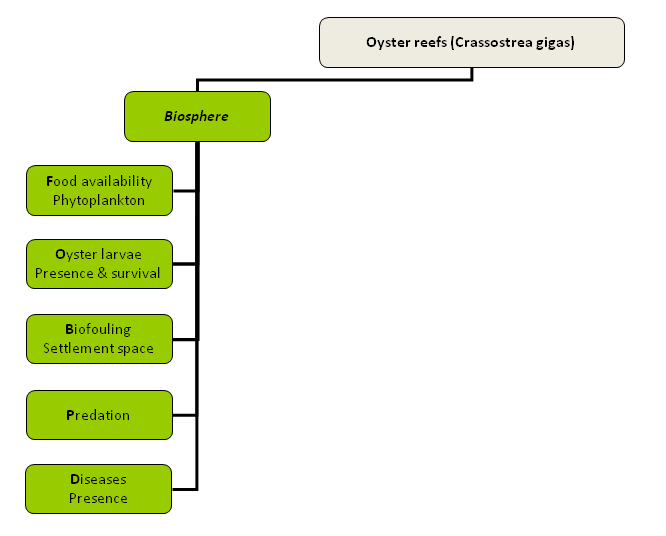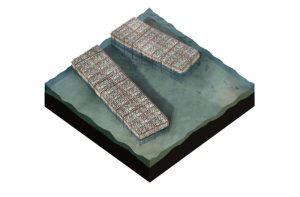Biosphere (all living organisms) – shellfish

Food availability: Like other bivalves, oysters collect their food by actively filtering and sorting particles from the water. The particles that oysters feed on are mainly phytoplankton, but include also zooplankton, protists and dead particulate organic matter. Oysters growing on artificial reefs might compete with other shellfish in the area. This competition may result in overgrazing, i.e. depletion of edible particles (Schellekens and Smaal, 2012).
Oyster larvae: Oysters reproduce by releasing eggs and semen in the water column. After fertilization, oyster eggs evolve to oyster larvae which live a planktonic life in the water column before settling. Oyster larvae can be transported over large distances before they settle (Troost, 2010). Physical transport, biological movement of the larvae and site- and larval-specific conditions may produce spatial and temporal patterns of abundance that are important determinants of management strategies. To create living reefs, artificial substrate reefs need a sufficient supply of larvae, and are preferably situated in close vicinity to natural oyster brood stocks. This will guarantee a sufficient supply of oyster larvae to the reef.
Biofouling: In the higher intertidal zone oysters compete for bare hard substrates with other fouling organisms such as barnacles and algae. Sometimes, one can get around this problem by introducing the artificial substrate reef during a period with high abundances of oyster larvae or low abundances of barnacle larvae in the water column (Brown and Swearingen, 1998). Fast growing algae often appear soon after deployment of artificial oyster reefs and overgrow the reef cab. Biofilms may also have an effect on settlement (Troost, 2010). Presence of sufficient grazers such as periwinkles (Littorina spp.) can reduce algal biofouling (Walles, unpublished) but might also negatively affect oyster larvae through grazing and bulldozing.
Predation: Shell production on oyster reefs is a key determinant for the long-term development and growth of reefs. The longevity of an oyster reef depends on continued recruitment, formation of shells and mortality. Predation can have a negative effect on reef development. Population dynamics of the Pacific Oyster and the Eastern Oyster (Crassostrea virginica) shows high numbers of newly settled oysters on a natural reef followed by a steep decline in numbers before the age of 1 (Walles et al., unpublished). This decline may be associated with predation by e.g. crabs or shrimps. Eggleston (1990) showed crab predation on Crassostrea virginica, till a prey refuge size of 45 – 50 mm. Sufficient recruitment is needed to overcome this predation mortality.
Diseases: Oysters are susceptible to various diseases which can severely deplete local populations and reduce harvests. Once Eastern Oyster populations in Chesapeake Bay (USA) outgrow predation pressure, they continue to suffer high mortality associated with the diseases Haplosporidium nelsoni (MSX) and Perkinsus marinus (Dermo caused by a protozoan parasite.) This results in oysters rarely exceeding the age of 4 years (Mann et al., 2009; Harding et al., 2010; Southworth et al., 2010). In Europe, Bonamia ostreae, a parasitic protist spread in the early 1970s and 1980s drastically reduced the production of Ostrea edulis in almost all European traditional rearing areas. Disease control focuses on containing infections and breeding resistant strains and is the subject of ongoing research. In the Eastern Scheldt, Pacific Oysters older than 1 year show low mortality rates (Walles et al., unpublished). As this system is not yet affected by diseases, large/old oyster are observed on natural oyster reefs. Large shells, associated with old oysters, have a higher contribution to reef growth which is important for reef development and maintenance.

